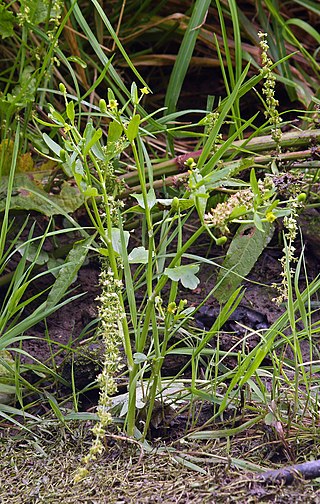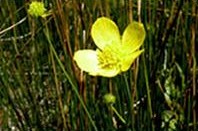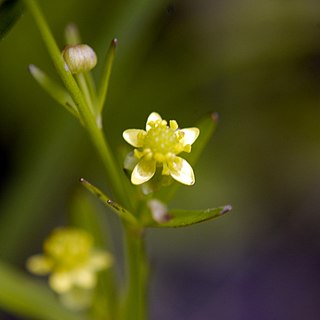
Ranunculus is a large genus of about 1700 to more than 1800 species of flowering plants in the family Ranunculaceae. Members of the genus are known as buttercups, spearworts and water crowfoots.

Ranunculus acris is a species of flowering plant in the family Ranunculaceae, and is one of the more common buttercups across Europe and temperate Eurasia. Common names include meadow buttercup, tall buttercup, common buttercup and giant buttercup.

Ranunculus glaberrimus, the sagebrush buttercup, is a species of flowering plant in the buttercup family, Ranunculaceae. It is native to interior western North America, in western Canada, the western United States, and the northwestern Great Plains.

Ranunculus sceleratus known by the common names celery-leaved buttercup, celery-leaf buttercup, and cursed buttercup is a species of flowering plant in the buttercup family Ranunculaceae. It has a circumpolar distribution in the northern hemisphere, native to temperate and boreal North America and Eurasia, where it grows in wet and moist habitats, including ponds and streambanks.

Ranunculus arvensis, the corn buttercup or field buttercup, is a plant species in the family Ranunculaceae. Native to Europe, it can be found on other continents as an introduced species and sometimes a weed, including in North America and Australia. It was formerly a common annual arable weed in Britain, but is now rare there. It is most often found in moist places, such as spring puddles in meadows.

Ficaria is a small genus of several species of plants in the family Ranunculaceae, which were previously grouped with Ranunculus. The genus includes Ficaria verna, known as fig buttercup or lesser celandine, and related species. The name "Ficaria" is Classical Latin for fig. Plants in the genus are closely related to true buttercups, but generally have only three sepals and swollen smooth achenes.

Ranunculus jovis is a species of buttercup known by the common name Utah buttercup or Jupiter buttercup. It is native to the mountain west of the United States, from Nevada to Wyoming. It is a petite plant, growing a few centimeters tall on hairless stems with a few deeply divided fingerlike leaves at the base. It produces yellow flowers with five rounded petals, yellow stamens around a central nectary.

Ranunculus gmelinii, Gmelin's buttercup or small yellow water-crowfoot, is a species of flowering plant in the buttercup family, Ranunculaceae. It is native to northern North America, where it occurs across Canada and the northern and higher-elevation regions of the United States. It is also present in Eurasia.

Ranunculus flabellaris is a species of flowering plant in the buttercup genus, Ranunculus, known by the common name yellow water buttercup. It is native to much of North America, including the southern half of Canada and most of the United States.
Ranunculus hydrocharoides is a species of buttercup known by the common names frogbit buttercup, or frog's-bit buttercup. It is native to western North America, including the southwestern United States and Mexico. It is also known from Guatemala. It is aquatic or semi-aquatic, growing floating in water or in wet land near water. Typical habitat includes marshes, streams, and lakes. Stems are up to 25 centimeters long, prostrate on the ground when terrestrial, or floating when aquatic. The shiny green leaves have heart-shaped or oval blades up to 3 centimeters long which are borne on petioles which may be 15 centimeters in length. Flowers have 5 to 8 shiny yellow petals a few millimeters long with many stamens and pistils at the center. The fruit is an achene borne in a spherical cluster of 9 or more.
Ranunculus lobbii is a species of buttercup known by the common name Lobb's buttercup, or Lobb's aquatic buttercup. It is native to a few areas in western North America, where it is reported from British Columbia, Oregon, and northern California. It is an aquatic plant, growing in various types of shallow-water habitat, including forest ponds and vernal pools. It is an annual herb producing submerged stems 20 to 80 centimeters long which may float at the surface. The blades of the leaves are tiny and divided into threadlike segments. If any leaves develop on stem parts which are exposed to air they are much different in morphology, developing larger, more robust leaves. Flowers have generally 5 petals which are white in color and about half a centimeter long. Many stamens and pistils fill the center of the flower. The fruit is an achene borne in a spherical cluster.

Ranunculus macounii is a species of buttercup known by the common name Macoun's buttercup. It is native to much of North America, from Alaska and northwestern Canada to Newfoundland and Labrador, and the contiguous United States except for the northeast and southeastern areas. It grows in many types of moist habitat, including marshes and wet areas woodlands and scrub. It is generally semi-aquatic, growing in or next to shallow water, or in muddy places. It is a perennial herb producing prostrate, spreading stems that root at nodes that come in contact with moist substrate, or growing erect and branching. The stems are generally hairy, but populations of hairless specimens are known. The leaves are mostly divided into three lobed, toothed leaflets which are borne on long, hairy petioles. The flowers each have five shiny yellow petals under a centimeter long around a center of many stamens and pistils. The fruit is an achene borne in a spherical cluster of 20 or more.

Ranunculus pusillus, commonly called low spearwort, is a species of flowering plant in the buttercup family (Ranunculaceae). It is native to much of the eastern United States from New York to Florida and west to Texas; it is also known in California. It grows in wet habitat, where it is semi-aquatic growing partially submerged or terrestrially on muddy substrates.

Ranunculus aestivalis is a rare species of buttercup known by the common names fall buttercup and autumn buttercup. It is endemic to the state of Utah in the United States, where it exists only in Garfield County next to the Sevier River. It is restricted to a moist microhabitat in an otherwise dry, open ecosystem, and the amount of available habitat is very limited. This is a federally listed endangered species of the United States. It has been described as "the most graceful and showy members of the genus in the western United States," but also "one of the state's rarest and most restricted plants."

Ranunculus pedatifidus is a species of buttercup known by the common names surefoot buttercup, northern buttercup, and birdfoot buttercup. It has a circumpolar distribution, occurring throughout the northern latitudes of the Northern Hemisphere. There are two varieties, var. pedatifidus occurring mostly in Asia and var. affinis mostly native to North America.

Ranunculus abortivus is a species of flowering plant in the buttercup family, Ranunculaceae. Its common names include littleleaf buttercup, small-flower crowfoot, small-flowered buttercup, and kidneyleaf buttercup. It is widespread across much of North America, found in all ten Canadian provinces as well as Yukon and the Northwest Territories, and most of the United States, except Hawaii, Oregon, California, and parts of the Southwest.

Ranunculus micranthus is a flowering plant species in the Ranunculus (buttercup) family known by the common names rock buttercup and small-flowered crowfoot. It is native to North America, with a distribution that covers much of the eastern United States. R. micranthus is very similar in appearance to R. abortivus. The distinguishing characteristics are the hairiness of their receptacles and shininess of their achenes.

Ranunculus hispidus is a species of perennial flowering plant in the buttercup family, Ranunculaceae. It is commonly known as bristly buttercup or hispid buttercup. It is a small plant native to central and eastern North America that grows to a height up to 30 cm (1 ft) and has 5-petaled yellow flowers.

Ranunculus fascicularis, commonly called early buttercup, is a species of flowering plant in the buttercup family (Ranunculaceae). It is native to the eastern North America, where it is found in Canada and the United States. It is generally widespread in eastern North America, although its populations become sporadic in areas east of the Appalachian Mountains and south of New England. Its natural habitat is in dry areas with sparse vegetation, such as rocky or sandy bluffs, prairies, and savannas.

















